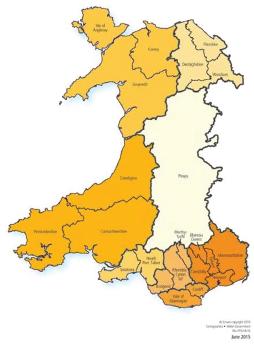News
If Dyfed is the answer, what was the question?

 LAST week Leighton Andrews, Public Services Minister for Wales, published the Welsh Government’s preferred plans for redrawing the map of local government in Wales. The plans unveiled had been well trailed and boil down to recreating the large unitary authorities that were part of the Welsh civic and political landscape for 22 years up to 1996.
LAST week Leighton Andrews, Public Services Minister for Wales, published the Welsh Government’s preferred plans for redrawing the map of local government in Wales. The plans unveiled had been well trailed and boil down to recreating the large unitary authorities that were part of the Welsh civic and political landscape for 22 years up to 1996.
In Wales’ fiercely independent west, the vision presented by the Welsh Government means recreating Dyfed. It appears, however, that the Welsh Government faces not only an uphill battle to get its reorganisation plans accepted by grassroots councillors, but also a stiff challenge to the prospect of even getting them on the statute book at all.
Council l eaders speak out
The issue highlighted by all of West Wales’ council leaders is that of cost and the threat to local accountability.
Cllr Ellen ap Gwynn, Leader of Ceredigion County Council, said: “Ceredigion County Council has previously voted unanimously against any merger proposals; this stance remains unchanged. Merging with any other authority would weaken local accountability, and so it is in the county’s citizens’ best interests to retain the sovereignty of Ceredigion. As the WLGA has recommended, local accountability would be best served by employing a combined authority model, which would consist of Ceredigion, Powys and Carmarthenshire cooperating on common strategic matters – an arrangement which would also negate any democratic deficit. Ceredigion remains committed to cooperate with other Councils to share resources and expertise in order to secure the most efficient and effective services possible. Bearing in mind that the Council has already made savings of £25 million over the past three years and needs to make similar savings over the next three years, concentrating on these proposals does not offer any benefits for the people of the county. It would be much better to see the estimated £268m cost of these proposals being spent on local services, rather than taking an empty, expensive step back in time.”
In a press statement last week, Cllr Emlyn Dole, Leader of Carmarthenshire, offered a more poetic view of the situation: “We have in Carmarthenshire a distinctiveness in culture, language and heritage – these are precious, and ours to retain and nurture. To that end, I firmly believe that Carmarthenshire should stand alone as a local authority in any future reorganisation of local government. One of my last acts as leader of the opposition on Carmarthenshire County Council, before becoming Leader, was to put down a motion on notice making this very point. I also put to council that maintaining our status as a county and an area authority offers us the best opportunity to safeguard and improve our services, and enables us to continue with the regeneration of our local economy. I was pleased to see cross party support, with all members – bar one – giving their full support. Having said that, I am not an inflexible Leader, and I will listen to all arguments for and against – indeed I do merit regional working arrangements.”
Cllr Jamie Adams, Leader of Pembrokeshire, was equally keen on retaining the distinctiveness of his county: “Seeing the maps for the first time, it is difficult to comment without some explanation of the rationale behind it. My position has always been: will the change improve the services we deliver to the public while at the same time reducing costs? If it doesn’t tick those two boxes, I think it is right to question the validity of this exercise. Apart from the obvious loss of local decision-making and accountability, I also have concerns about the real damage reorganisation could do to a very successful brand. I am referring to the Pembrokeshire name which is instantly recognisable to those living far outside our County and even beyond Wales. A large number of local businesses in tourism, agriculture, food and energy depend on, and identify strongly, with brand Pembrokeshire for their livelihood. I fear they will inevitably suffer if amalgamation goes ahead and in these trying times I believe it would be foolish to gamble with the health of our local economy.”
Big is beautiful ,but not always
There is no doubt that bigger authorities are better able to administer some key local government services. Strategic planning and transport, education and social services all demand scale. Size can bring vision, specialist expertise and economy and flexibility in the use of resources. For these services, big is beautiful and a reduction in the number of local authorities is right. It might even be that 8 or 9 authorities are too many, particularly in respect of strategic planning and transport.
But sometimes small is beautiful as well. Local authorities ought to be more than just the deliverers of services, and councils that don’t obviously connect with the places they serve struggle to be civic leaders and place-makers. The performance of Wales’ biggest councils also shows that big isn’t necessarily better.
Despite the clarion calls of the city-region lobby, most of Wales consists of small towns and villages, and we ignore the governance and provision of services in these communities at our peril. It remains to be seen if the proposed role for town and community councils will fill this gap.
Plaid Cymru has tapped into this picture with its own proposals for reorganisation. Plaid’s response is to create regional consortia to deliver the services identified above, while retaining a direct link with the local electorate by retaining other services at the existing county level. In a debate in the Senedd, Carwyn Jones di smi s sed this plan as ‘creating seven new quangos’, but Plaid’s policy seems to bear remarkable similarities to that favoured by the Welsh Local Government Association.
Cllr Bob Wellington CBE, Labour leader of Torfaen and head of the WLGA, says: “The sustainability of authorities in Wales is in question over the next three years and it is time to examine all options for reforming public services across the board. This means looking at greater integration of health and social care, freeing up authorities from Government bureaucracy and regulation and also empowering local communities through their councils.”
As Mike Hedges AM, presciently wrote in a paper for the Bevan Foundation: ‘The last 40 years have seen two reorganisations, the creation of the National Assembly for Wales and services such as water, post-16 education and Magistrates’ courts being taken out of local authority control. After almost a hundred years with a stable structure, Local government in Wales was reorganised into county and district Councils in 1974 and further reorganised into 22 unitary authorities in 1996. If we continue changing local government structures every 22 years then we are due an Act in 2016 and a new structure in place by 2018’.
The case for reform
Not all visions of reorganisation are as apocalyptic as those offered by local government leaders. Wales Politico carries an article which cites two unnamed senior council officials as accepting that the need and case for reorganisation is overwhelming. The article quotes a South Wales officer as saying: “Everyone in local government knows it is the correct decision. But obviously we can’t say that publicly, because so many jobs will go – including our own.”
Writing in Click on Wales, Geraint Talfarn Davies goes as far to say that: “Fewer larger counties should entail a rejuvenation of this bottom tier, in ways that would encourage really local action. It has been the missing dimension in the debate. Those who want to see real local engagement should opt for fewer councils at the top and genuinely local entities at the very bottom, even more local than the existing councils. The message from a public that seems increasingly more concerned by quality of delivery than by democratic form is, for God’s sake get on with it, do it better, get results.”
Describing the progress of the reforms as ‘snail-paced’ and ‘ham-fisted’, The Daily Wales observed: ‘The reality is that just as turkeys will never vote for Christmas, local authority leaders will never vote for their own abolition’.
Whatever the future holds for Welsh local government, it seems that – with no hope of getting legislation through before 2016’s Assembly elections – the debate is going to run and run.
The question is, who will blink first?
Health
Resident doctors in Wales vote to accept new contract

RESIDENT doctors across Wales have voted to accept a new contract, with 83% of those who took part in a referendum backing the agreement, according to BMA Cymru Wales.
The contract includes a four per cent additional investment in the resident doctor workforce and introduces a range of reforms aimed at improving training conditions, wellbeing and long-term workforce sustainability within NHS Wales. The BMA says the deal also supports progress towards pay restoration, which remains a central issue for doctors.
Key changes include new safeguards to limit the most fatiguing working patterns, measures intended to address medical unemployment and career progression concerns, and reforms to study budgets and study leave to improve access to training opportunities.
Negotiations between the BMA’s Welsh Resident Doctors Committee, NHS Wales Employers and the Welsh Government concluded earlier this year. Following a consultation period, a referendum of resident doctors and final-year medical students in Wales was held, resulting in a clear majority in favour of the proposals.
Welsh Resident Doctors Committee chair Dr Oba Babs Osibodu said the agreement marked a significant step forward for doctors working in Wales.
He said: “We’re proud to have negotiated this contract, which offers our colleagues and the future generation of doctors safer terms of service, fairer pay, and better prospects so that they can grow and develop their careers in Wales.
“This contract will help to retain the doctors already in training, and also attract more doctors to work in Wales, where they can offer their expertise and benefit patients.”
Dr Osibodu added that the BMA remains committed to achieving full pay restoration and acknowledged that challenges remain for some doctors.
“Whilst this contract sets the foundations for a brighter future for resident doctors in Wales, we recognise that there are still doctors who are struggling to develop their careers and secure permanent work,” he said. “We need to work with the Welsh Government and NHS employers to address training bottlenecks and underemployment.”
The Welsh Government has previously said it recognises the pressures facing resident doctors and the importance of improving recruitment and retention across NHS Wales, while also highlighting the need to balance pay agreements with wider NHS funding pressures and patient demand.
The new contract is expected to be phased in from August 2026. It will initially apply to doctors in foundation programmes, those in specialty training with unbanded rotas, and new starters, before being rolled out to all resident doctors across Wales.
Crime
Swansea man jailed for online child sex offence dies in prison

A SWANSEA man who was jailed earlier this year for attempting to engage in sexual communication with a child has died while in custody.
Gareth Davies, aged 59, of the Maritime Quarter, was serving an 18-month prison sentence after being convicted in May of sending sexually explicit messages to what he believed was a 14-year-old girl. The account was in fact a decoy used as part of an online safeguarding operation.
The court heard that Davies began communicating with the decoy between November and December 2024 and persistently pursued the individual, later attempting to arrange a face-to-face meeting. He was arrested after being confronted by the decoy operators.
Davies had pleaded not guilty but was convicted following a trial. At the time of sentencing, police described the messages as extremely concerning and said his imprisonment was necessary to protect children.
It has now been confirmed that Davies died at HMP Parc on Wednesday (Nov 27) while serving his sentence.
The Prisons and Probation Ombudsman has launched an independent investigation into the death, which is standard procedure in all cases where someone dies in custody. No cause of death has been released at this stage.
A coroner will determine the circumstances in due course.
Farming
Welsh Conservatives warn climate plans could mean fewer livestock on Welsh farms

THE WELSH CONSERVATIVES have challenged the Welsh Government over climate change policies they say could lead to reductions in livestock numbers across Wales, raising concerns about the future of Welsh farming.
The row follows the Welsh Government’s decision, alongside Plaid Cymru and the Welsh Liberal Democrats, to support the UK Climate Change Committee’s Fourth Carbon Budget, which sets out the pathway towards Net Zero greenhouse gas emissions by 2050.
The Carbon Budget, produced by the independent Climate Change Committee (CCC), states that meeting Net Zero targets will require a reduction in agricultural emissions, including changes to land use and, in some scenarios, a reduction in livestock numbers.
During questioning in the Senedd, the Welsh Conservatives pressed the Deputy First Minister and Cabinet Secretary for Climate Change and Rural Affairs on whether the Welsh Government supports reducing livestock numbers as part of its climate strategy.
Speaking after the exchange, Welsh Conservative Shadow Cabinet Secretary for Rural Affairs, Samuel Kurtz MS, said the Welsh Government could not distance itself from the implications of the policy it had backed.
Mr Kurtz said: “By voting in favour of these climate change regulations, Labour, Plaid Cymru and the Liberal Democrats have signed up to the UK Climate Change Committee’s call to cut livestock numbers in Wales, and they cannot dodge that reality.
“The Deputy First Minister’s smoke-and-mirrors answers only confirm what farmers already fear: that Labour, along with their budget bedfellows in Plaid and the Lib Dems, are prepared to sacrifice Welsh agriculture in pursuit of climate targets.”
He added that the issue came at a time of growing pressure on the farming sector, pointing to uncertainty over the proposed Sustainable Farming Scheme, the ongoing failure to eradicate bovine TB, nitrogen pollution regulations under the Nitrate Vulnerable Zones (NVZs), and proposed changes to inheritance tax rules affecting family farms.
The Welsh Government has repeatedly said it does not have a target to forcibly reduce livestock numbers and has argued that future emissions reductions will come through a combination of improved farming practices, environmental land management, and changes in land use agreed with farmers.
Ministers have also said the Sustainable Farming Scheme, which is due to replace the Basic Payment Scheme, is intended to reward farmers for food production alongside environmental outcomes, rather than remove land from agriculture.
The UK Climate Change Committee, which advises governments across the UK, has stressed that its pathways are based on modelling rather than fixed quotas, and that devolved governments have flexibility in how targets are met.
However, farming unions and rural groups in Wales have warned that policies focused on emissions reduction risk undermining the viability of livestock farming, particularly in upland and marginal areas where alternatives to grazing are limited.
The debate highlights the growing tension between climate targets and food production in Wales, with livestock farming remaining a central part of the rural economy and Welsh cultural identity.
As discussions continue over the final shape of the Sustainable Farming Scheme and Wales’ long-term climate plans, pressure is mounting on the Welsh Government to reassure farmers that climate policy will not come at the expense of the sector’s survival.
-

 Crime1 day ago
Crime1 day agoMilford Haven man jailed after drunken attack on partner and police officers
-

 News4 days ago
News4 days agoDyfed-Powys Police launch major investigation after triple fatal crash
-

 Crime1 day ago
Crime1 day agoTeenager charged following rape allegation at Saundersfoot nightclub
-

 Crime2 days ago
Crime2 days agoMan charged with months of coercive control and assaults
-

 Crime3 days ago
Crime3 days agoMan sent to Crown Court over historic indecent assault allegations
-

 Crime5 days ago
Crime5 days agoMan spared jail after baseball bat incident in Milford Haven
-

 Crime3 days ago
Crime3 days agoMilford Haven man admits multiple offences after A477 incident
-

 Crime2 days ago
Crime2 days agoWoman ‘terrified in own home’ after ex breaches court order




















